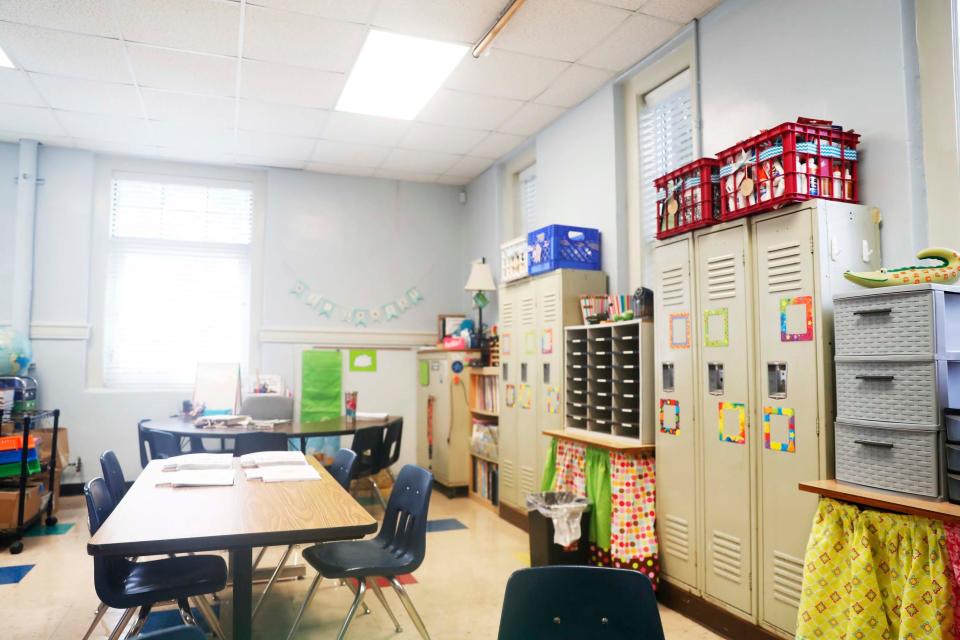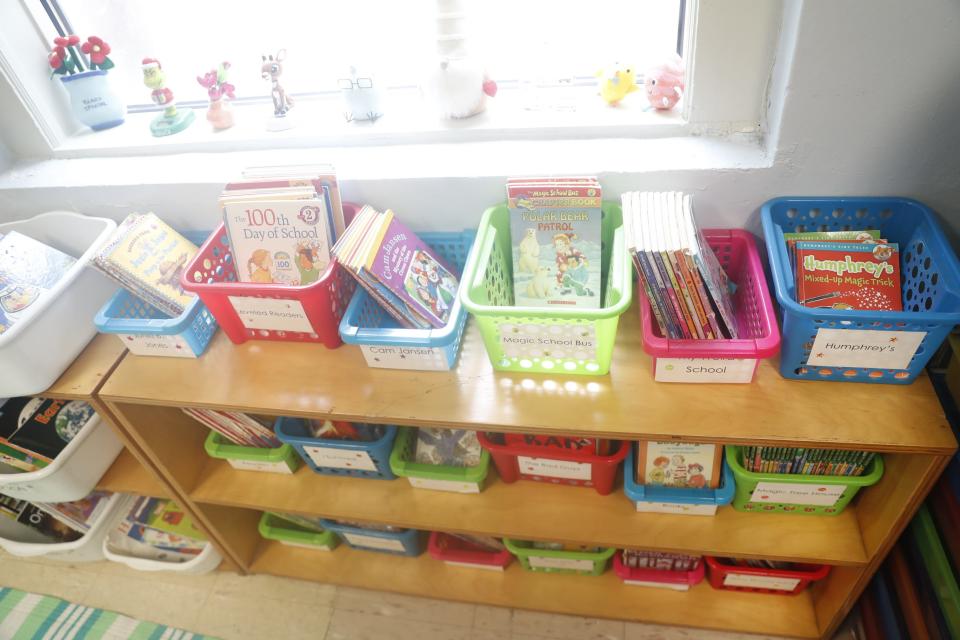Memphis schools get letter grades from state. Why MSCS leaders don't like them
Can you accurately describe the performance of a school with a letter grade, if the same evaluation method is used throughout the state and makes standardized test scores a driving factor?
Memphis-Shelby County Schools interim superintendent Toni Williams doesn’t think so. And this week, as the Tennessee Department of Education prepared to release public school’s letter grades on an A-F scale, she criticized the evaluation process and asserted that it doesn’t paint a full picture.
“It’s important to acknowledge that a single letter grade ― based largely on one week of standardized testing ― tells really only one part of the story,” she said during a call with members of the media on Wednesday. “Many of our students face significant challenges outside of the classroom. The system doesn't take into account the poverty, the lack of kindergarten readiness, the impact of community violence… These issues significantly impact learning... I urge state officials and stakeholders to work with us to develop a more holistic model that acknowledges the entire child ― not just a grade, but the whole child.”
Williams’ remarks came as many MSCS schools received grades on the lower end of the A-F scale. Of the 198 MSCS schools ― including charter schools ― that received letter grades, nine received As, 30 received Bs, 72 received Cs, 44 received Ds, and 43 received Fs. Statewide, 294 schools received As, 441 received Bs, 513 received Cs, 350 received Ds, and 92 received Fs.

But before we dive into the results, let’s examine how we got to this point.
The origin of letter grades
In 2016, a law was passed requiring TDOE to develop a school letter grading system. Schools would receive grades on an A-F scale for the previous academic year, which would give parents a chance to see how they were performing. They’d also be able to compare the results to the school’s past grades.
Originally, the first grades were slated to be assigned to schools in the 2017-18 academic year. But implementation was delayed first by online testing challenges, then the COVID-19 pandemic. And around seven years after the law’s initial passage, the grading system had yet to be deployed. So, this fall, when TDOE officials again geared up to evaluate schools using an A-F scale, they traveled throughout the state, holding town halls and gathering feedback from community members on how grades should be given.
The methodology
The last town hall was held on Sept. 7; and in October, TDOE leaders convened a working group comprised of education stakeholders from across Tennessee, which reviewed community feedback and made recommendations for the new letter grade calculations.
Then, on Nov. 2, TDOE released the letter grade calculations for elementary schools, middle schools, and high schools, which included four indicators: achievement, growth, a subgroup, and for high schools, college and career readiness.
More: MSCS board narrows field of superintendent finalists to three. Here's who's left.
The achievement indicator included proficiency success rates on the Tennessee Comprehensive Assessment Program tests and end-of-course exams. Test subjects were weighted differently, depending on the grade; and districts could opt to also include students taking advanced coursework and their associated exams.
The growth indicator, meanwhile, was measured by schoolwide Tennessee Value Added Assessment System results, which focused on students’ year-over-year academic growth on TCAP tests, rather than proficiency. The subgroup indicator focused on the year-over-year academic growth of the lowest-performing students, which meant those scoring in the bottom 25% on TCAP tests. And the college and career readiness indicator measured the percentage of the graduating class with at least one of the following:
A score of 21 or higher on the ACT;
A postsecondary credit-earning score via AP, IB, Cambridge, CLEP, dual credit or dual enrollment;
An industry credential (Tier III or Tier II plus one other industry credential);
An Armed Services Vocational Aptitude Battery qualifying score.

Some indicators also did more to determine a school’s final score. Here’s how they were weighted, broken down by school level.
Elementary schools
Achievement: 50%
Growth: 40%
Subgroup (lowest 25%): 10%
Middle schools
Achievement: 50%
Growth: 40%
Subgroup (lowest 25%): 10%
High schools
Achievement: 50%
Growth: 30%
Subgroup (lowest 25%): 10%
College and career readiness: 10%
The indicator received a sub-score of 1 to 5, which was multiplied by the assigned weights to calculate a school’s overall score. And this score was translated into a letter grade with the following scale:
A: 4.5-5
B: 3.6-4.5
C: 2.6-3.5
D: 1.6-2.5
F: 1-1.5
When TDOE leaders gave an overview of the calculation to the state Board of Education in early November, they explained that it was meant to be a simpler, easier-to-understand way to illustrate school performance for families.

Some board members, however, were skeptical. School board vice chair Darrell Cobbins, for example, worried the new grading system could have a disproportionately negative impact on schools in high-poverty areas.
"Does it become a self-fulfilling prophecy when teachers, students, families opt out for something better?" he said at the time. "It's a struggle for me to understand saying everyone should pull themselves up by their bootstraps when some folks have a closet full of boots and some have none."
'It's concerning'
Williams shared a similar sentiment when she spoke to members of the media this week, as she encouraged TDOE to find another way to evaluate schools.
“When you compare a school district that's located somewhere on the east side of Tennessee versus the west side of Tennessee, there are some challenges economically, there's some challenges with poverty, there's challenges in our city with crime,” she said.
More: With federal funding drying up, MSCS is looking to save hundreds of jobs. Here's how
She and other MSCS leaders maintain they’re not using issues like poverty as an excuse for schools with Ds and Fs, but they see a correlation between the two. Many MSCS students come from low-income families, and about 46% of the schools that received Fs in Tennessee are part of the local district.
“In our own analysis, our schools that have the higher percentages of economically disadvantaged students tend to get the lower grades,” said Bill White, MSCS’ executive director of planning and accountability, during the meeting with members of the media. “There's going to always be some exceptions to that; we also don't want to use that as an excuse. But it is something that I think we all have to always be aware of and cognizant of. Because we need to make sure that our neediest students are getting really the resources and attention that they need.”
When TDOE officials toured the state and gathered feedback from the public on letter grade calculations, people expressed concern about how issues like poverty can affect learning; and on Wednesday, The Commercial Appeal asked MSCS leaders why they thought the education department hadn’t done more to incorporate thoughts around these areas into the final calculations.
“I'd hate to speculate on the whys there,” White said in response. “I do just think it’s concerning and disappointing that this process felt rushed, looking in on it, and just didn’t seem to include as much input as we would have liked.”
TDOE officials, however, maintain that they did keep community feedback in mind as they developed the calculations. When presenting the calculations to state education board members in early November, David Laird, Tennessee Department of Education's assistant commissioner of assessment and accountability, touted the efforts made to engage the public.

“We did an enormous amount of engagement to try and solicit feedback," Laird said.
Victoria Robinson, assistant commissioner of communication and engagement, said all students were considered and pointed to the subgroup of lowest-performing, highest-need students.
"All students are taken into account," she said. "The 'other indicator' for highest-need students recognizes academic growth for the students who are the furthest behind, the bottom 25%, no matter who they are."
What's next
Time will tell exactly how schools that received poor letter grades will be affected. Accountability measures are outlined in the Tennessee Investment in Student Achievement plan, which determines public school funding; and a TDOE spokesperson said schools receiving "a D or F rating are subject to appear for hearings before the State Board of Education, which could result in requirements for corrective action planning or financial and/or academic audits conducted by the department." And in early November, Tennessee Education Commissioner Lizzette Gonzalez Reynolds addressed a state board member’s question about whether there would be punishments for schools with poor letter grades.
"We're not going to go in there and take away their money or slap them around," Reynolds said at the time. “The public will know how they’re doing with their kids. At the end of the day, it’s got to be about the kids."

MSCS leaders also seem to believe it should be about kids. They have praised the nine schools that received As: East High School, Medical District High School, Middle College High School, Richland Elementary, University Middle School, White Station High School, Campus School, University High School, and Winridge Elementary School. But they wonder whether the letter grades being given are in students' best interest.
“There's been a lot of debate across the country about, ‘Does that really do more harm than good, just labeling a school with an F?’” White said. “We have our data, we know where our kids are struggling… We have to really dig in to, not so much what's behind the F, but what is behind each individual child's needs, to meet them where they are.”
There were 210 schools in Tennessee that did not receive a letter grade due to "data suppression and business rules," per TDOE. For example, some public school programs geared toward adult learners were not given a letter grade. In total, Tennessee has around 1,700 public K-12 schools eligible for letter grades, according to department data; and it's not the only state using letter grades. They're also being given to schools in Alabama, Arizona, Arkansas, Georgia, Florida, Mississippi, North Carolina, Oklahoma, and Texas. If you're wondering what letter grade a specific school earned, visit reportcard.tnedu.gov and enter the name of the school in the search bar at the top right.
Rachel Wegner contributed to this report.
This article originally appeared on Memphis Commercial Appeal: MSCS schools get letter grades from Tennessee Department of Education

